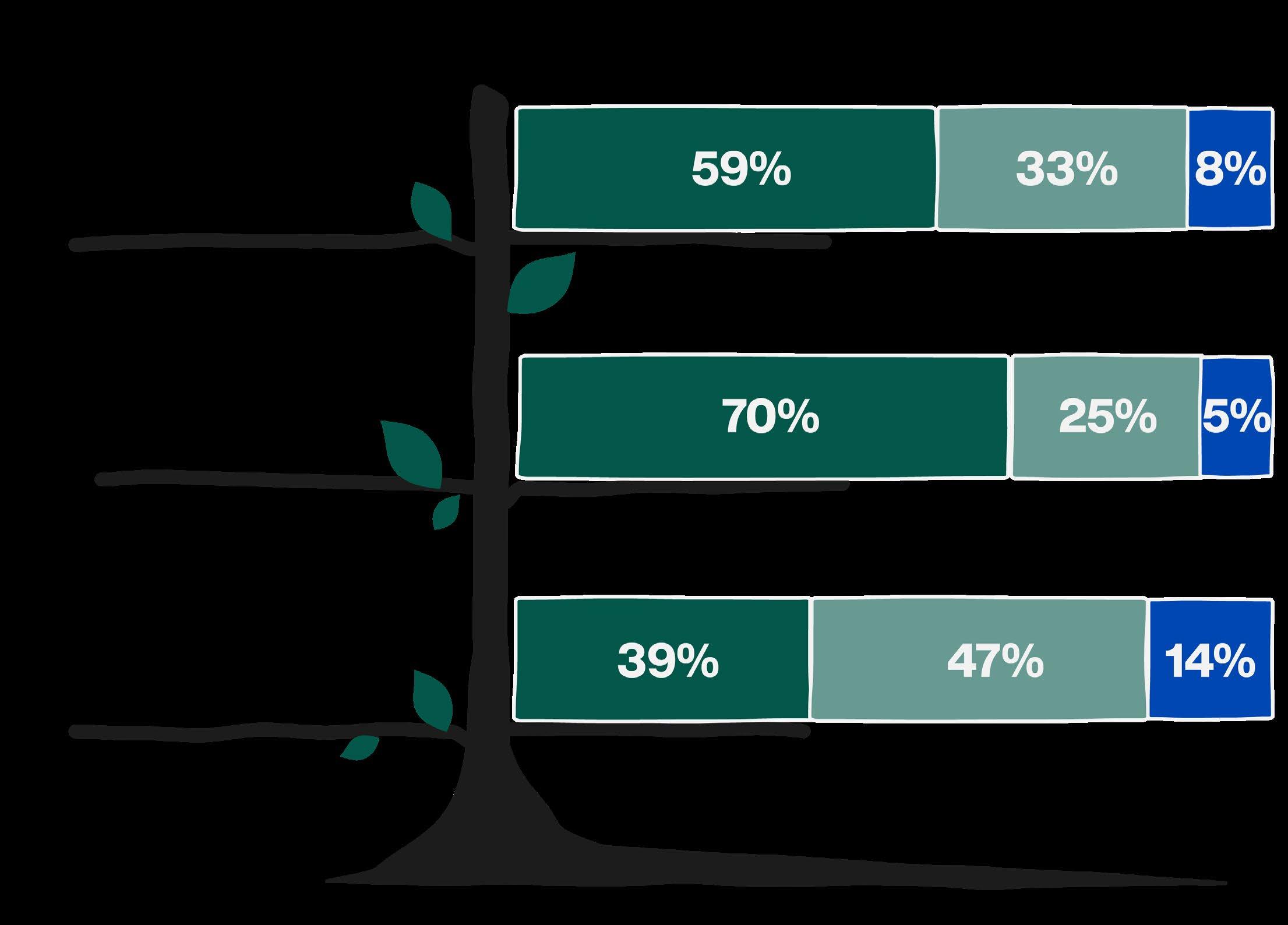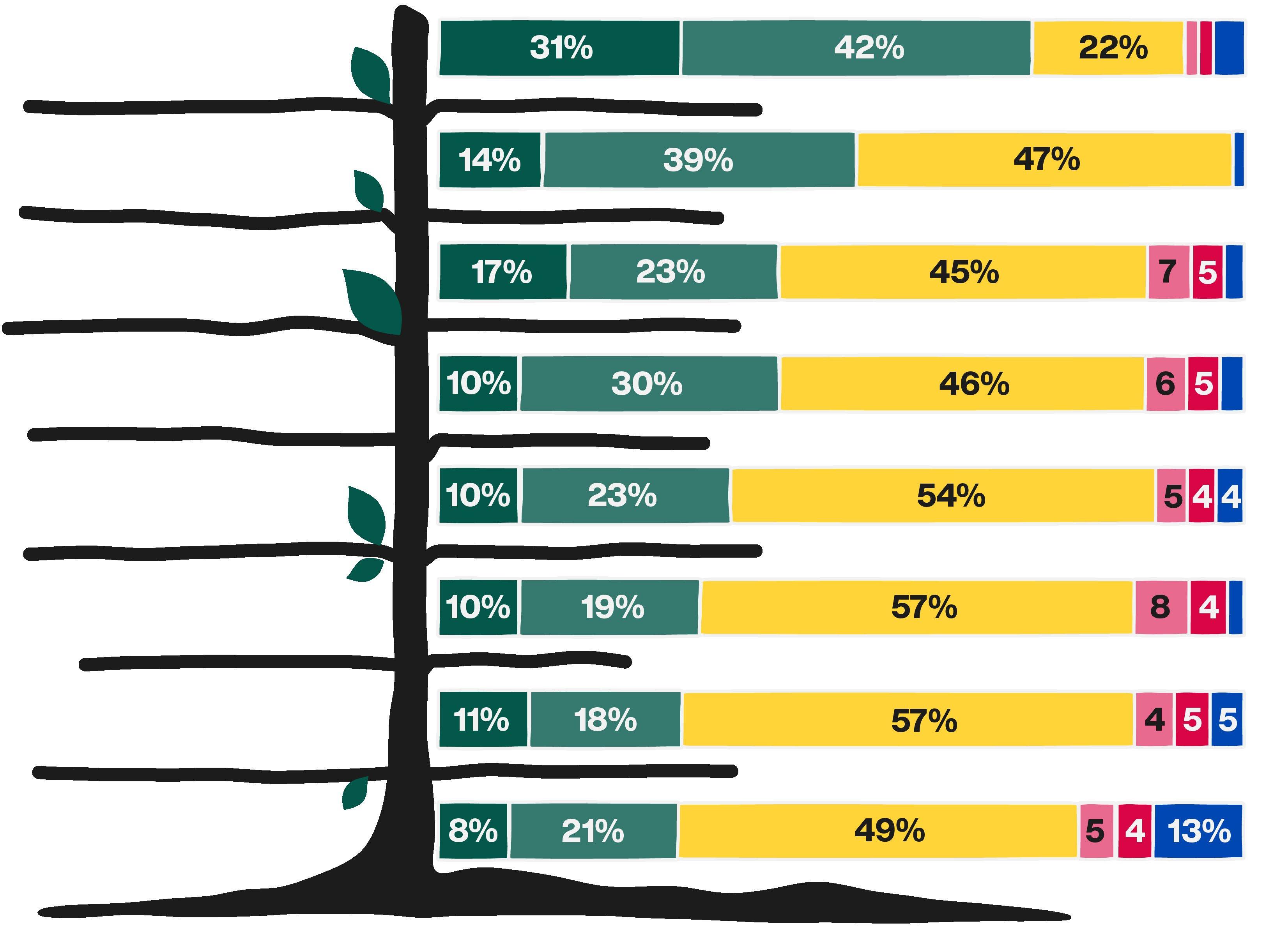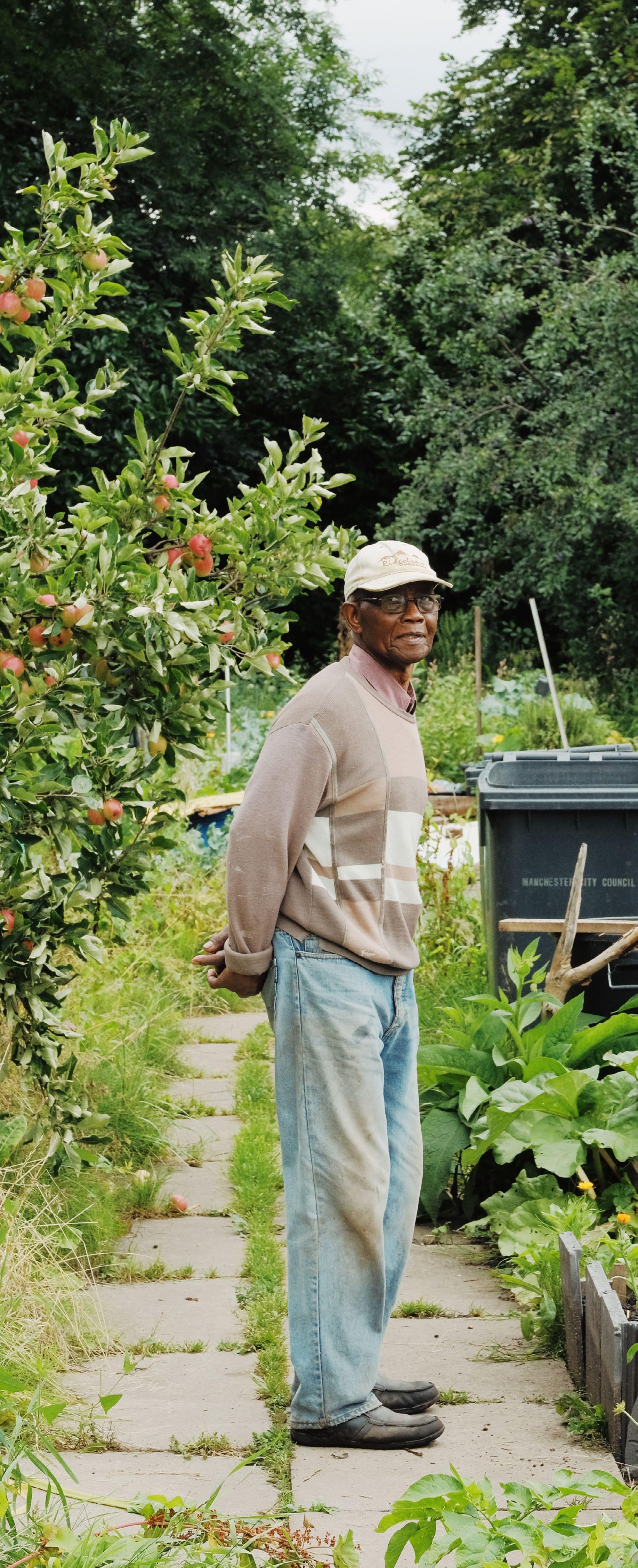Community nature projects and climate action: connecting the dots









It’s well documented that spending time in nature improves our health and make us feel happier. Research shows that the more connected we feel to nature, the more likely we are to take part in everyday behaviours that are good for the environment.
Hubbub and Wates Family Enterprise Trust have partnered to explore the role of nature as a springboard to inspire and connect, with the goal of using nature as a catalyst to build a movement of people taking grassroots climate action.
Alongside Chrysalis Research, we conducted on-theground research in collaboration with community-led nature projects across Greater Manchester to understand:
• Does taking part in a community nature project lead to an increased connection to nature?
• Does deeper connection to nature lead to proenvironmental behaviours and attitudes?
• What makes a successful community project?
This is a summary of the research, and the full report is available on request. Get in touch: hello@hubbub.org.uk

We worked with 19 community projects that involved regular activities that brought people together in nature. For some groups this meant gardening and landscaping, and for others it focused on activities around culture, food and wellbeing.



Nature connectedness research focuses on the behavioural, emotional and psychological relationship that people have with nature. This connection can change over our lives and is influenced by not only how much time we spend in nature, but also:
..the simple things we about it
..the we experience in nature ..the we attach to it.
These influences, also known as the pathways to nature connection, can underpin connection to nature within community projects.
The community nature project activities we studied featured one or more of these influences - most notably the sounds and smells of nature.
We found a plant that smells like chocolate!”
Project participant
I feel much more aware of my surroundings in nature and my impact on the environment.”
Project participant
What we found:
• 92% of 182 participants felt a deeper and stronger engagement to nature due to their involvement in community nature projects.
• The longer they were involved, the more likely this connection was.

Agreement with
“My engagement with nature got deeper and stronger”
All participants = 182
Longer-term engagement = 116 (4 or more visits to the project)
Strongly agree
Strongly disagree
Agree Neither Disagree
Initial engagement = 66 (less than 3 visits to the project)

Conclusion:
Taking part in community nature projects, for any length of time, increased participants’ connection to nature.

 Fig 1. Participants change in engagement with nature
Fig 1. Participants change in engagement with nature
We asked project participants if they undertook any of five common ‘pro-environmental behaviours’ during their projects and/or in their personal lives. The behaviours focused on sustainable actions, sharing knowledge and inspiring others, food and consumption.
of participants took at least one pro-environmental action [on] the project (and almost three actions per participant on average). 93%
• The most common actions within the projects were: ‘helping others learn about the environment’ and ‘trying to avoid using plastic’.
• Personal behaviours were also impacted, with nearly a third growing their own food, followed by buying local / organic food and reducing food waste.
• 64% of participants agreed that the community projects made them feel more capable of personal action to tackle climate change.
• Participants became more comfortable discussing climate change, with almost two-thirds of the longer-term engagement group reporting speaking about it more.
I cycle and use public transport a lot more. I have made my garden more wild and wildlife-friendly and want to make a natural pond like the one at the market garden.”
Project participant
Seeing the vegetables being grown has encouraged me to include them more in my diet, whether it’s literally the ones we’ve grown here or reminding me to buy and try more veg when I’m doing my weekly shop.”
Project participant
Appreciate nature even more and [try to] be kind to others, eat more organic food and less meat, and buy second-hand clothes more, use less plastic.”
Project Lead
For those reporting no change in behaviour, there were two main reasons for this:

1 2 They had already adopted those behaviours.
It wasn’t relevant to their involvement in the project, for example, their focus was on their children’s enjoyment of the space or their own wellbeing.

 Sam, Project Lead and Director at Platt Fields Market Garden
Sam, Project Lead and Director at Platt Fields Market Garden
“Whilst working on this project or being part of this group, have you done any of these actions?”

Did something to protect the natural world or encourage different kinds of life (biodiversity)
All participants
Longer-term engagement
Initial engagement
Tried to avoid using plastic
Tried to avoid using pesticides
Used less water and/or collected rain water
Helped other people to notice, value or learn about nature and the environment

“How much have the following changed as a result of you coming here/to this project?”
Noticeable positive change
Small positive change
Stayed the same / No change
Small negative change
Noticeable negative change
Not applicable

Growing your own food or plants
Buying local or organic food
How much food you throw away
How much plastic you use
Your use of gas, electricity or petrol
The amount of water you use
How much / often you buy
The amount of meat you eat
Fig. 2 Actions people took as part of the project Fig. 3 Actions people took in their personal livesWhilst the level of concern about climate change remained unchanged for many participants, people reported feeling a greater sense of agency and being more empowered to take personal action because of taking part in a community nature project.
64%
of participants agreed that taking part in the project made them feel they could do more themselves to tackle climate change, this was more apparent for participants who engaged with their project for a longer period of time (69%).
• Many participants highlighted feeling more in control, believing it is possible to make a difference and had greater clarity about how – by making personal changes and involving others.
• A number of participants flagged that climate change was rarely discussed directly within the projects. Project leads understood this and instead framed sustainable behaviours around the benefits they bring, which meant participants felt more empowered to act.
• Many participants commented that taking part in their project helped them overcome feelings of anxiety and helplessness about climate change.
• 57% of participants became a lot more comfortable about talking to others about climate change after taking part in the project, this increased to 62% for participants who had engaged in the project long-term.
It feels a bit less futile. I meet a lot of people with the same views, and it feels like we are at least all doing something in our area and hopefully can bring more people with us.”
Project participant
I regularly check my children’s understanding of why all this matters and how it will affect their lives and the world.”
Project participant
It’s an environment that’s conducive to being able to emphasise what’s possible. And then, by building community and connection hopefully people don’t feel so alone; [they start to feel they] can join in and become part of something that is making a difference [to something much bigger.]”
Project Lead
For many participants, being involved in their project not only prompted them to adopt more proenvironmental behaviours but also increased their sense of agency and empowerment to take climate action.



ening a nd gro g To be in ired by nature
Factors that made a difference:
Focus on the benefits and sense of satisfaction
Shifting mindsets and identities L


To b creative

To et new people

To harvest and eat food grown this way is a fabulous achievement and knowing it has been done in complete harmony with nature gives enormous satisfaction and pride.”
Project participant
I am inspired to grow, be in nature and be an active member of my community focused on sustainable, community focused living and care for our local environment.”
Project participant
The community factor –being around people who are also making changes
Being around like-minded people has helped me to realise the big impact of my small actions.”
Project participant
Leading with the benefits and starting with small steps
If I went up and said, ‘I think we need to talk about the climate crisis,’ they’d all move away and say, ‘No. No, thank you very much.’
Project Lead
Being reminded about positive choices
Seeing the vegetables being grown has encouraged me to include them more in my diet, whether it’s literally the ones we’ve grown here or reminding me to buy and try more veg when I’m doing my weekly shop.”
Project participant
We say to people, ‘Would you come down and just dig some compost for us? Or make a pond. Come down and plant some flowers or put some seeds in a pot. And you’re doing something positive.”
Project Lead
We explored what the features are of nature projects which support changes in environmental attitudes and behaviours. We have summarised this in three key recommendations for groups running community nature-based projects:
Successful projects understood and focussed on what motivates participants to return week after week: to do something for their local community and the environment, to meet new people, and to improve their wellbeing. They also offered skills and benefits that participants could apply in their personal lives, which made them more willing and able to adopt pro-environmental behaviours at home.
For example, teaching people how to grow their own produce and incorporate new ingredients into their everyday cooking. One group showed participants how to cook a quick and delicious swede recipe, which led to more people opting to grow veg and wasting less swede when preparing it.
I was already very environmentally conscious, but I felt pressured by the [project] community to not drive there, as they encourage only local, walking distance people using it. It has really stopped me driving locally as much, even though it’s often hard work with two small kids to get anywhere!!”
Project participant
Lead by example
Successful projects often had important principles and ‘ground rules’ which focused on the wellbeing and benefits to local people and nature.
For example, suggesting visitors can only take part if they walk or wheel to the sessions. For Bluebell Green in Levenshulme, this led to participants cutting car use in their personal life too.
Other examples include avoiding pesticides or plastic, encouraging biodiversity, and reducing and preventing food waste demonstrating credibility and reinforcing environmental actions.
Among the 19 projects, nearly all participants commented that they had done or learnt something worthwhile. As people became more engaged, they moved from activities like weeding and planting to more specialist activities such as preserving produce, nature walks, and collaborating with local schools.


The ability to learn and develop, whilst supporting their community and being around like-minded people, was a key factor for people to feel a part of a group, and keep coming back.


Before conducting on-the-ground research with community-led nature projects, we did a comprehensive literature review to understand existing research into nature connectedness and community nature projects.
The research was then designed with communities in mind. We wanted to develop a methodology that could be applied to real-world situations, be replicated elsewhere and be reflective of the dynamic (and sometimes beautifully unpredictable) nature of community work.
Our data collection approach involved:
• A survey with 182 participants about the project activities and any pro-environmental behaviours inside the project or in their own life.
• Interviews with 10 participants exploring activities and individual changes in their connection to nature and pro-environmental behaviours.
• Follow up in-depth interviews with project participants and project leads from across five community nature projects where we had noticed particularly strong impact in behaviour change, to understand in detail the factors that had helped to bring this about.


This research has found that there is a clear correlation between participation in community nature projects and increased nature connectedness and proenvironmental behaviours. Whilst connection to nature plays an important role in community nature projects, the connection to other people and to the local community is often the most important factor in developing a sense of agency and empowerment to take climate action.
Community projects play a vital role in our response to climate change, and there are many practical ways to adapt activities with projects to include nature in a way that’s practical, relevant and inclusive for everyone, and support people to take climate action in their everyday lives.

Our 3-step approach to using nature as a hook to inspire climate action:

Enable positive experiences in nature: that’s what makes people turn up.

Foster a sense of community: that’s what makes people come back.

Make people feel part of something bigger: to empower people to act.
Thank you to the following community groups for their involvement and time as part of this research project:
• Ashville Gardens, Ashville Surgery
• Bluebell Green, Friends of Chapel Street Park
• Bugs and Beats, Our Sale West
• Castleford Viaduct
• Clean and Green Castlefield
• Derek Jarman Pocket Garden
• Fallowfield Secret Garden
• Hulme Community Garden Centre
• Marbury Road Edible
• Ossory Street Allotment
• Plant Co-operative Evening Gardening Club
• Platt Fields Market Garden, Manchester Urban Diggers
• RHS Bridgewater
• Riverbank Community Garden
• The Kindling Trust
• The Landing Stockport
• Wai Yin Society Welcome Centre
• Whalley Rangers Gardeners
Many thanks for Wates Family Enterprise Trust for their continued support to help make nature inspirational, relevant and inclusive.
Click on the projects to find more about their amazing work and get involved


Building on learnings from this research and our insights from working with communities, we’re on a mission to bring people closer to nature and nature closer to people by supporting community-led green spaces to thrive.
We’re currently working to create, connect, support and champion a network of green spaces across the UK, launching in Summer 2024.
The Nature Network will offer funding opportunities, free resources, templates and peer to peer support to community groups who wish to establish new or improve existing green space.
Want to learn more about our research and next steps?
Sign up for updates.
Read more about WFET and Hubbub’s work together.




